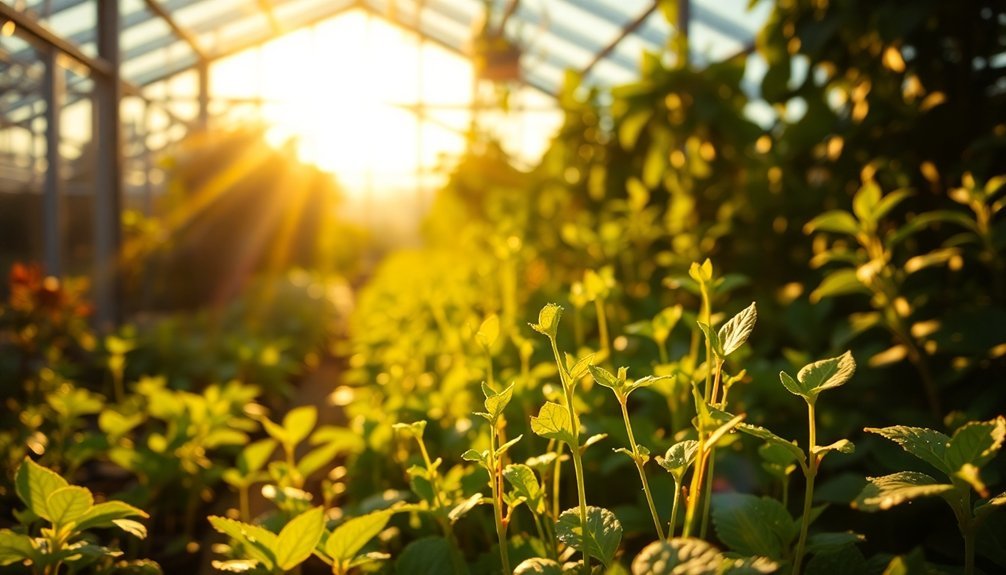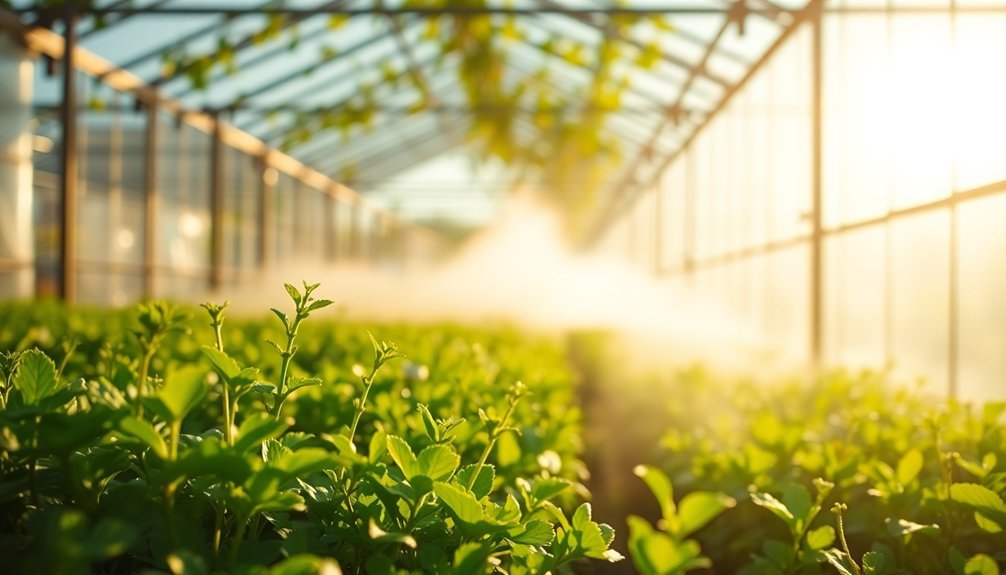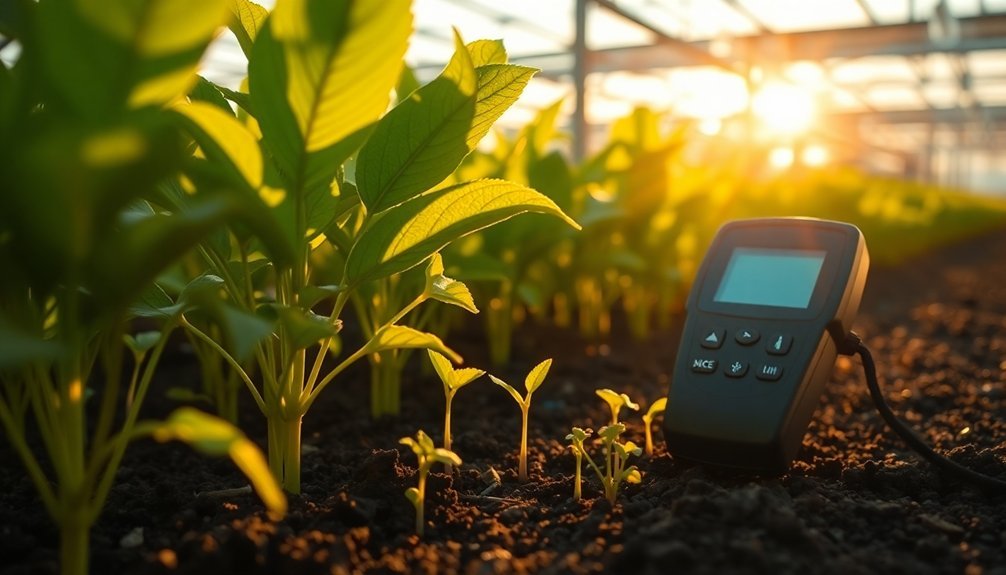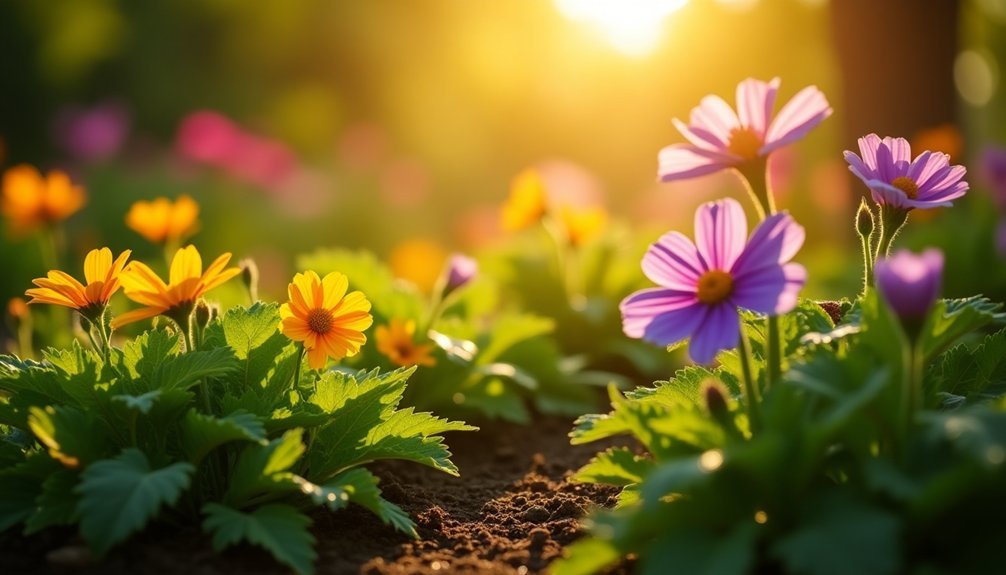Most plants need 12-16 hours of daily light for ideal growth, but you'll want to adjust based on your specific plants. Give seedlings 8-10 hours, decorative plants 12-14 hours, and edible or flowering plants 14-16 hours. Don't forget about darkness – all plants require at least 8 hours of dark time for healthy development. Use timers to maintain consistent schedules, and monitor your plants' response to fine-tune their perfect light exposure. Your journey to mastering plant light cycles is just beginning.
Understanding Plant Light Classifications

Whether you're starting a garden or maintaining indoor plants, understanding plant light classifications is essential for successful growth.
Plants fall into two main categories based on their light exposure needs: short-day plants and long-day plants.
Short-day plants, like strawberries and cacti, need longer periods of darkness and thrive when daylight lasts less than 12 hours.
In contrast, long-day plants such as lettuce and spinach require more than 12 hours of light to reach their flowering stages.
To guarantee healthy growth, you'll need to adjust the ideal light duration for each type.
Daily Light Duration Requirements
Building on our understanding of plant light classifications, let's explore specific daily light requirements for ideal plant growth. Different plants need varying light duration based on their species and growth stage. Most plants need 12-16 hours per day of light exposure, with decorative indoor plants requiring a lower DLI compared to edible plants.
| Plant Type | Light Hours/Day | Daily Light Integral |
|---|---|---|
| Seedlings | 8-10 | 1-5 mol/m²/day |
| Decorative Plants | 12-14 | 1-4 mol/m²/day |
| Edible Plants | 14-16 | 10-30 mol/m²/day |
| Flowering Plants | 14-16 | 12-25 mol/m²/day |
When using grow lights, you'll want to adjust light requirements based on your plant's vegetative stage. Remember that all plants need at least 8 hours of darkness for healthy metabolic processes, regardless of their Daily Light Integral needs.
Growth Stage Light Adjustments

Just as plants evolve through distinct growth phases, their light requirements change considerably throughout their lifecycle.
During seedling stages, you'll want to provide 12-16 hours of light exposure to establish strong growth. As your plants enter the vegetative stage, increase light hours to 16-18 daily to maximize leaf development.
Proper light exposure is crucial – start with 12-16 hours for seedlings, then increase to 16-18 hours during vegetative growth.
- Picture your seedlings stretching toward the light, developing their first true leaves
- Imagine lush, green foliage expanding during the vegetative stage under extended light
- Visualize flowering plants blooming beautifully under shorter light duration
When your plants shift to flowering, reduce light duration to 10-12 hours.
Don't forget about dark periods – they're essential for plant health. Confirm seedlings get 6 hours of darkness, while mature plants need 8-10 hours for ideal growth.
Maintain perfect light intensity throughout each stage for the best results.
Setting Up Light Schedules and Timers
To achieve consistent plant growth, establishing a reliable light schedule with automated timers is crucial.
You'll need to take into account that different plants require varying light durations – long-day plants need 12-16 hours, while short-day plants thrive with 8-12 hours of light exposure.
Set up a programmable timer or smart outlet to maintain consistent minimum hours of light for your plants. Start with at least 8 hours and adjust based on your plants' needs.
Remember to provide adequate darkness periods, as plants need at least 8 hours of dark time for healthy development.
Position your light fixtures properly to guarantee even light distribution, and regularly monitor plant responses to your light schedule.
If you notice signs of stress or leggy growth, adjust your timer settings accordingly to promote ideal growth conditions.
Monitoring and Fine-Tuning Light Exposure

While establishing a light schedule is essential, monitoring and fine-tuning your plants' light exposure guarantees peak growth throughout their lifecycle.
You'll want to regularly check your specific species' responses and adjust duration accordingly. Use a light meter to measure light intensity, ensuring it falls within 10-30 mol/m²/day for edible plants. Remember to maintain 12-16 hours of light and 8-10 hours of darkness for optimal health.
- Picture yourself as a plant detective, observing leaf colors and growth patterns that signal light satisfaction
- Imagine using a timer as your reliable assistant, maintaining consistent light schedules day after day
- Visualize gradual 30-minute adjustments, like a gentle sunrise or sunset, preventing shock to your plants
Always consider environmental factors like temperature and humidity, as they work together with light exposure to create perfect growing conditions.
Frequently Asked Questions
How Many Hours a Day Should a Plant Be Under a Grow Light?
You'll want to keep your grow lights on for 12-16 hours daily, giving plants at least 8 hours of darkness. Adjust timing based on your specific plant's needs – some may require more or less light.
What Is the Best Schedule for Grow Lights?
You'll want to run your grow lights for 12-16 hours daily, starting early morning. Set timers from 6 AM to 8-10 PM, ensuring plants get 8 hours of darkness for recovery.
How Many Hours of Light Do Most Plants Need?
You'll want to provide most plants with 12-16 hours of light daily. Remember to give them at least 8 hours of darkness for recovery. Indoor plants can thrive with 8-10 hours of direct light.
What Is the Best Light Setting for Plant Growth?
You'll get the best plant growth with 12-16 hours of light and 8-10 hours of darkness daily. Adjust based on your plant type—long-day plants need more light, while short-day plants require longer dark periods.
In Summary
Now you've got the essential knowledge to provide ideal lighting for your plants. Remember to match light schedules to your plants' specific needs, adjust duration based on growth stages, and use timers for consistency. Don't forget to monitor your plants' responses and make tweaks as needed. With these lighting basics mastered, you'll be well on your way to growing healthy, thriving plants.





Leave a Reply